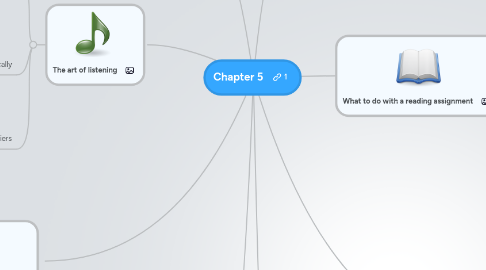
1. Reading actively and critically
1.1. Skimming and scanning
1.1.1. Can be used to get a feel for the material
1.1.2. Read the first and last paragraphs and the main headings of the text
1.1.3. Should be done before in depth reading
1.2. Questioning
1.2.1. Question the source's purpose
1.2.1.1. Is the author credible?
1.2.1.2. Is there an agenda or bias?
1.2.1.3. Does it aim to persuade or to inform?
1.2.2. Writing questions in the margins of the text is a good place to start
1.3. Evaluating
1.3.1. Evaluate material for its credibility and usefulness
1.3.2. Determine whether or not the material is reliable
2. Developing your reading skills
2.1. Building your vocabulary
2.1.1. Look for context clues
2.1.2. Look for words in the dictionary to help build your vocabulary
2.2. Checking your comprehension
2.2.1. Answer any questions at the end of each chapter
2.2.2. Write a short summary of the chapter
2.3. Improving your reading attention span
2.3.1. Figure out how many pages you can read comfortably
2.3.2. Keep a reading log
2.3.3. Try to improve upon that number
3. The art of listening
3.1. Preparing to listen and listening actively
3.1.1. Avoid distractions
3.1.2. Prepare to listen before class
3.1.3. Maintain a positive attitude
3.1.4. Prepare for class both psychologically and physically
3.2. Listening critically
3.2.1. Focus on the task at hand
3.2.2. Concentrate on what is being conveyed
3.2.3. Critical does not necessarily mean negative
3.3. Reducing listening barriers
3.3.1. Ask the instructor to slow down or define the terms if necessary
3.3.2. Talk to a counselor about any learning or hearing difficulties
4. Note-taking strategies
4.1. Listen for the main ideas
4.2. Leave plenty of "white space" when taking notes
4.3. Review your notes as soon as possible after class
4.4. Develop a shorthand
4.5. Use an outline
4.6. Annotating the margins of your textbook
5. What to do with a reading assignment
5.1. All written materials from professors need to be read
5.2. Treat the reading seriously
5.2.1. Have a positive attitude
5.2.2. Make a conscious effort to read and remember important information
5.2.3. Organize assignments according to size, importance, and due date
5.3. How to read effectively
5.3.1. Set a definite time and place to read
5.3.2. Learn to understand and set purposes for reading
5.4. Set specific goals for reading
6. Reading in the disciplines
6.1. Math
6.1.1. Read both written and visual explanations
6.1.2. Read assigned chapters before class
6.2. Literarure
6.2.1. Start longer assignments early
6.2.2. Take notes as you read
6.2.3. Read the material more than once if it is very complex
6.2.4. Pay special attention to detail when reading fiction and poetry
6.3. Languages
6.3.1. Use a dictionary whenever you encounter new vocabulary
6.3.2. Work to improve speed
6.4. Sciences
6.4.1. Focus on new concepts
6.4.2. Look for visual representations of the content
6.5. Social Sciences
6.5.1. Look for key ideas
6.5.1.1. People and their theories or actions
6.5.2. Learn the who, what, when, and where
7. Important terms
7.1. Active listening
7.1.1. Listening with focus and a purpose
7.2. Active reading
7.2.1. Reading to remember and understand
7.2.2. Reading with a purpose
7.3. Comprehension
7.3.1. Ability to remember and understand
7.4. Context clues
7.4.1. Hints of a word's meaning by how it is used in a sentence
7.5. Critical listening
7.5.1. Listening to evaluate the information
7.6. Critical reading
7.6.1. reading to evaluate and to question
7.7. Dyslexia
7.7.1. A learning disability that makes it difficult for a person to read, spell, or listen effectively
7.8. Listening barrier
7.8.1. An obstacle that keeps you from listening effectively
7.9. Outlining
7.9.1. An arrangement of information that is ordered by how information is presented
7.10. SQ3R
7.10.1. A reading strategy that stands for survey, question, read, recite, and review
7.11. Subvocalization
7.11.1. Sounding out individual words while reading
7.12. T System
7.12.1. A note-taking strategy that involves dividing your paper into an upside-down T
7.13. Table of Contents
7.13.1. A list of the chapter titles and section headings in a book
7.13.2. Appears at the beginning of a book
8. Reviewing your notes
8.1. Reviewing should be done within two days of the time you took them
8.2. Ask yourself questions on the material
8.2.1. Why is it important to know this?
8.3. Freewriting
8.3.1. Write down all the information that you can remember from the class
8.3.2. Give yourself 5 to 10 minutes to freewrite
8.3.3. Do not stop even if you can't spell a word or get stuck on particular idea
